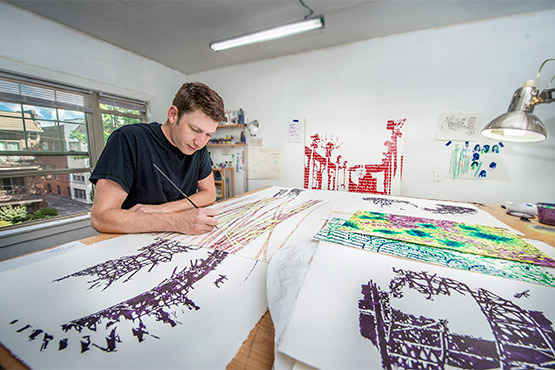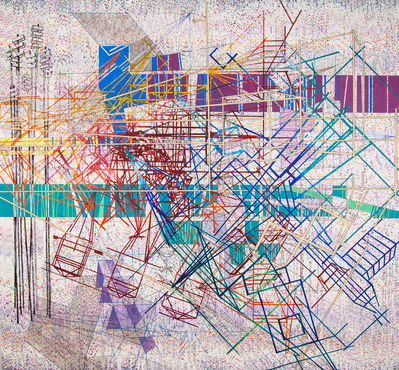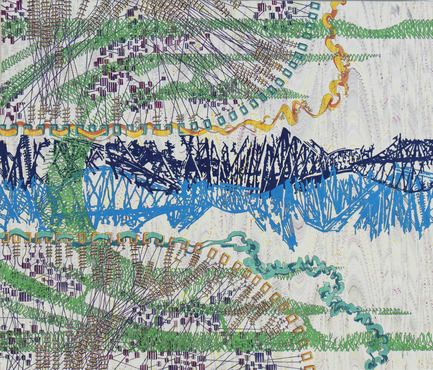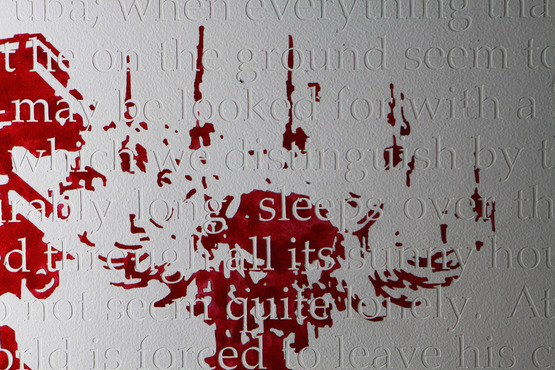
News . Feature Stories . Complicated Beauty
News
September 14, 2016
Complicated Beauty
Painting chair Ingrisano labors over love for systems

Photo by Robert Muller/CIA.
By Clint O’Connor
In Tony Ingrisano’s paintings and drawings, floating bridges, unhinged runways, and powerless power grids converge in a futuristic collage of precarious patterns. The intricate systems often derive from reality, but they don’t lead to earthly destinations.
The eye is deceived, unsure where to focus. A closer look at the elaborate shapes reveals multiple layers. The canvas itself is a concoction: dozens of super-thin paper strips rearranged and painted over. It’s a laborious task to create a system within systems.
Ingrisano is assistant professor and chair of CIA’s Painting Department. But he’s also a working artist, who, in his studio, faces some of the same questions about craft and content that he helps students solve at school.
“I think it’s the doing of it that keeps me doing it,” he says. “Each piece takes about a month to a month and a half. I’m probably the most stoked about the thing I just spent the most time on. I really think it’s the process that is the drive and the push.”
That process has led to several shows, including two solo exhibitions at Lesley Heller Workspace in New York.
“Tony turns infrastructure systems into something very beautiful and interesting looking,” says Lesley Heller, owner of the gallery that represents him. “I love the layering and collaging. It makes the viewer think about what he is playing with, so it works on several levels.”
A few years ago, Ingrisano found himself researching power lines as part of a project for artist Patrick Jacobs, who had been commissioned to create an urban landscape. Ingrisano discovered images of bizarre beehives of cables from third world countries, where unregulated electrical lines invite splicing and slicing.
“They look incredibly dangerous, but also very cool, like a beautiful drawing in space,” he says. “That’s what really got me started thinking about systems, and what happens when they are overloaded. So I started drawing power lines that don’t connect to anything.”
Those led to bridges, roller coasters, airport runways, sewer systems and subways.
Ingrisano, who just started his third year at CIA, is smart, engaging, and enthusiastic. There is an irony underlying his artistic works. Though his shapes often lead to a disconnected nowhere, he is determined to help his students reach solid creative ground.
“One of things that really drew me to teaching was to see students through a project,” he says. “To kind of pull out what they really want and then help them get there. A lot of students have great ideas, but are a little bit out to sea as how to make that happen. That’s what I consider to be my number one job, finding ways to bring what they are envisioning to life.”
He does that by exposing them to as much as possible, and encouraging lively discussions. “I do a lot of slide shows. I bring in not just theoretical writing, but also a lot of radio shows and multimedia access points and give them assignments that really push the limits of what they make.”
In the past, there was a sense that painting majors had been doing less and less actual painting. But Ingrisano, along with fellow professor and former chair Lane Cooper, has been steering students back to the brush.
“We encourage students to work with multimedia, and experiment with a lot of different things, but painting and drawing still hold a really strong role in contemporary art, and contemporary art discourse,” Ingrisano says. “Every 10 years there’s a new article that says, ‘Painting is Dead.’ But there are still a whole bunch of people painting.”
Ingrisano, 36, bounced around as a kid, moving for his dad’s job as a lieutenant colonel in the U.S. Army. Born in Connecticut, his family lived in Georgia, Indiana, Kentucky, Germany and Massachusetts. The Army Brat life meant Ingrisano and his sister never spent too long in one town or one school.
“I hated it and it drove me nuts,” he says, “but I also loved it at the same time. When you’re in elementary school, it’s really hard to leave your friends and be the new kid. But when you’re an adult, that background helps you work through tough situations. It turns out it was really worth it.”
After studying art at the University of Vermont, he earned an MFA from Pratt Institute in Brooklyn, NY. Initially a CIA visiting artist and lecturer, he became an assistant professor last year.
He met his wife Michelle Sammons, an art historian, at a gallery in Brooklyn in 2010. They married four years later, and Ingrisano started teaching at CIA the day after returning from their honeymoon in South Africa and Botswana. They share a two-bedroom apartment in Cleveland Heights with their dog and cat, and Ingrisano commutes to CIA on his bike. The second bedroom is his studio, a bright space with windows overlooking the street.
“His work is very different from when I first met him,” says Sammons, who teaches an art history class at CIA. “He was doing a lot of graphite on paper of large scale animals. I thought they were really beautiful, but he was struggling with the content. He felt people liked it, but it wasn’t really the subject matter that the art world wanted.”
His more recent work includes a text-driven piece that incorporates passages from Emerson’s “Nature” essay. The white-on-white letters can be discerned more clearly when they run through painted outlines of a church. “The idea is that the words remove something from the image,” says Ingrisano. “They continue to fight against the thing that is sitting on top of them.”
It is the forerunner for pieces he plans to create about displacement. Ingrisano has spent the past year meeting with Syrian refugees in Toledo through US Together, an organization that helps newly arrived refugees. He will turn their stories into art for part of a show at Spaces early next year focusing on the first 100 days of the new presidency.
Navigating the swirling waters of the presidential election and immigration issues is a new direction, but not necessarily the direction.
“I am excited to dive into this political bent and we’ll see where it goes,” he says. “It could be great, but maybe not. I don’t think I’ll ever be one type of artist. I don’t want to be a systems artist. I don’t want to be a political artist. I don’t want to be just a painter or a drawer. I want to explore what I want to explore.”
Latest Headlines view all
-
April 02, 2024
Cleveland Institute of Art students partner with Progressive Art Collection to exhibit Ready, Set, Relay! -
March 04, 2024
Cleveland Institute of Art announces Curlee Raven Holton Inclusion Scholar Program -
November 06, 2023
Collision of art and artificial intelligence creates murky waters for artists, curators and educators
Questions?
For more information about this or other CIA news, contact us here.










Social Feed